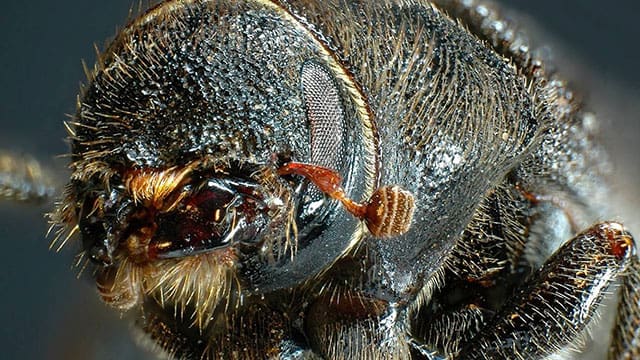Higher levels of greenhouse gases may have both positive and negative effects on the invasive mountain pine beetle
New research from the University of Alberta shows that climate change is interfering with mountain pine beetle reproduction, but it also appears to provide some minor benefits to the invasive insects in other ways.
The mixed scenario provides “a deeper understanding of dynamics that are crucial to building effective forest management and conservation strategies in the face of ongoing environmental changes,” says Rashaduz Zaman, who led the study, working toward a PhD in forest biology and management from the Faculty of Agricultural, Life & Environmental Sciences.
 Rashaduz Zaman |
 Nadir Erbilgin |
The study – the first to show specifically how the mountain pine beetle is affected by elevated levels of two greenhouse gases, carbon dioxide and ozone – provides new insight into how climate change influences the insect and its relationship with beneficial fungi.
On an apparent upside for the insect – but detrimental for the lodgepole forests it attacks – lab experiments showed that exposure to higher levels of carbon dioxide accelerated the beetle’s typical one-year cycle of egg-laying, hatching and maturing by at least five days, which could in turn lead to more rapid population growth and higher infestation rates.
The finding could potentially help develop better management strategies to combat the beetle’s invasion of boreal forests, says Zaman.
The beetle invades trees near and far, and accelerated development could make the insect larger, allowing it to fly farther. This would make it more difficult to pinpoint and manage far-flung infestation sites.
“This insight is crucial for mountain pine beetle management because it suggests that areas with clusters of attacked trees nearby, resulting from short-distance dispersal, may be more manageable from a control perspective,” Zaman notes.
“Concentrating control efforts in these relatively small areas could be more effective in containing infestations and preventing their spread to new locations. Forest managers and policy-makers can tailor their management strategies to target specific areas more efficiently.”
The researchers were also surprised to find that despite the beetle’s reduced reproduction rates, within a single generation, the higher ozone exposure also improved the insect’s ability to survive against a parasitic fungus that usually kills it.
“Brood beetles demonstrated normal behaviour despite the environmental challenges that affected their parents, which could be due to an increased response from defence-related genes,” Zaman suggests.
Experiments conducted under drier, less humid conditions, which are expected with climate change, also affected saprophytic fungi. This type of fungi is usually harmful because it outcompetes the beetle’s beneficial fungi.
But lower humidity flipped that equation, providing beneficial fungi for the beetle broods to feed on, Zaman notes. “This could ultimately benefit the beetles, with a higher likelihood of reproduction success and range expansion.”
The research also showed detrimental effects on the beetle.
Exposure to higher ozone levels reduced the insect’s ability to deposit its larvae in the tree bark, meaning fewer eggs were laid.
The production of pheromones – airborne chemical signals the beetles use to communicate in numbers large enough for mating and reproduction – was also altered.
That means their ability to mate could be impaired, Zaman says.
When exposed to high ozone levels, the insects produced about 10 broods per log, compared with 100 broods produced in more ambient conditions.
The research also showed that elevated levels of the two greenhouse gases affected the growth of the beneficial fungi the beetle carries with it to trees. Such fungi perform valuable services for the insect, including providing minerals and nutrients.
While some of the species showed enhanced growth from higher exposure to the greenhouse gases, others declined.
“That means changes in the growth rate of these symbiotic fungi may cause irregularities in the normal functioning of the beetle’s life cycle and invasion strategy.”
Overall, the study shows just how complex the effects of climate change are for the beetle and its beneficial fungal partners, says U of A forest entomologist Nadir Erbilgin, who supervised the study.
“While both are affected by changing environmental conditions, the effects aren’t uniform between them, which makes it difficult to understand the dynamics for predicting and managing the impacts of climate change on forest ecosystems.”
A better understanding of those dynamics could help improve strategies for managing the mountain pine beetle, such as monitoring programs, scientific modelling and genetic research, he adds. He noted that his lab is further exploring several of those aspects and is planning to conduct studies spanning more of the insect’s broad geographical range.
“All of this knowledge can help scientists, policy-makers and conservationists work towards more targeted, effective strategies for mitigating mountain pine beetle outbreaks to minimize the damage to forests.”
| By Bev Betkowski
This article was submitted by the University of Alberta’s Folio online magazine, a Troy Media Editorial Content Provider Partner.
The opinions expressed by our columnists and contributors are theirs alone and do not inherently or expressly reflect the views of our publication.
© Troy Media
Troy Media is an editorial content provider to media outlets and its own hosted community news outlets across Canada.



